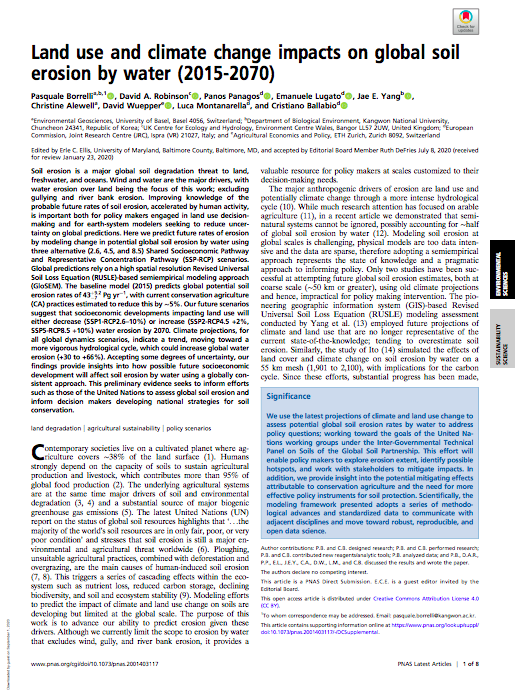Land use and climate change impacts on global soil erosion by water (2015-2070)

ABSTRACT
Soil erosion is a major global soil degradation threat to land, freshwater, and oceans. Wind and water are the major drivers, with water erosion over land being the focus of this work; excluding gullying and river bank erosion. Improving knowledge of the probable future rates of soil erosion, accelerated by human activity, is important both for policy makers engaged in land use decisionmaking and for earth-system modelers seeking to reduce uncertainty on global predictions. Here we predict future rates of erosion by modeling change in potential global soil erosion by water using three alternative (2.6, 4.5, and 8.5) Shared Socioeconomic Pathway and Representative Concentration Pathway (SSP-RCP) scenarios. Global predictions rely on a high spatial resolution Revised Universal Soil Loss Equation (RUSLE)-based semiempirical modeling approach (GloSEM). The baseline model (2015) predicts global potential soil erosion rates of 43þ9.2 7 Pg yr−1 , with current conservation agriculture (CA) practices estimated to reduce this by ∼5%. Our future scenarios suggest that socioeconomic developments impacting land use will either decrease (SSP1-RCP2.6–10%) or increase (SSP2-RCP4.5 +2%, SSP5-RCP8.5 +10%) water erosion by 2070. Climate projections, for all global dynamics scenarios, indicate a trend, moving toward a more vigorous hydrological cycle, which could increase global water erosion (+30 to +66%). Accepting some degrees of uncertainty, our findings provide insights into how possible future socioeconomic development will affect soil erosion by water using a globally consistent approach. This preliminary evidence seeks to inform efforts such as those of the United Nations to assess global soil erosion and inform decision makers developing national strategies for soil conservation.